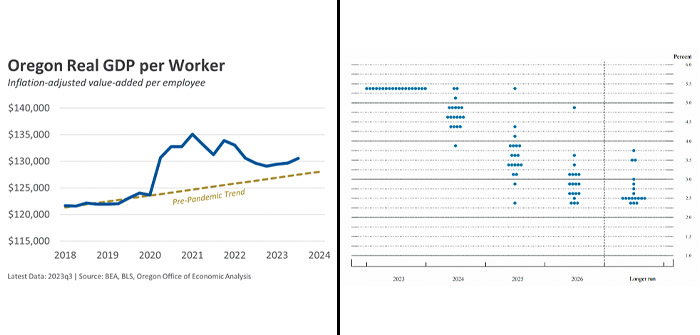(Graphs courtesy of EDCO)
Central Oregon finds itself on the cusp of economic transformation during 2024, riding the tide of a nation in flux. The state economic forecast paints a picture of a rebalancing economy, with inflation hovering above the Federal Reserve’s target but showing signs of moderation. The key drivers of change include stronger productivity gains, a cooler labor market and a surge in Americans seeking employment. These dynamics set the stage for a nuanced economic landscape in Central Oregon, prompting a closer examination of the region’s economic trajectory.
Labor Market Rebalancing and its Impact
One pivotal aspect for Central Oregon is the rebalancing of the labor market. Labor force participation has increased across the nation and regional companies are filling job openings faster than a year ago. Many local employers who had double-digit vacancies have now filled most of those critical positions. Vacancies remain, but present gaps in labor force should continue closing in 2024 for most companies.
Currently, 5,423 jobs are pending in EDCO’s list of active projects across Deschutes, Crook and Jefferson County, the majority of which are in advanced manufacturing. Other notable industries include scientific, lifestyle products and high technology. While not all these projects will come to fruition in 2024, this metric serves as an indication of the potential for strong regional employment expansion. As wage growth slows, inflation is anticipated to follow suit. This, coupled with recent data showing increasing employee productivity shown in the ‘Oregon Real GDP per Worker’ graph, offers a welcome respite for businesses in the coming year.
Federal Reserve’s Role in Economic Stabilization
While monetary policy can be difficult to predict, experts at the Federal Reserve foresee interest rates will fall in 2024, making capital more available. At the Federal Open Market Committee (FOMC) meeting in September 2023, participants submitted projections of their expectations of federal interest rates for each year from 2023 to 2026, and beyond. Projections were based on information available at the time of the meeting and her or his assessment of appropriate monetary policy and assumptions about other factors likely to affect economic outcomes. Each circle in the accompanying graph indicates the value of an individual participant’s response¹. While there is variation, most of those surveyed expect interest rates to decrease in 2024 and in the coming years. Monetary policy aims to strike a delicate balance and Central Oregon, a microcosm of the larger economic landscape, stands to benefit from decreasing interest rates to drive economic growth.
Oregon’s Baseline Economic Outlook
Drawing from the broader state economic and revenue forecast released in late November, Central Oregon’s economic trajectory aligns with Oregon’s baseline outlook. The region’s economic growth hinges on the dual pillars of achieving full employment and fostering increased business investment and productivity gains. EDCO’s pending projects currently represent a potential for almost $4 billion in capital investment across the region. Census data affirm that the recovery from the pandemic has been inclusive and broad-based, setting the stage for a resilient economic landscape. According to the state forecast, there are indications that “productivity will pick up in the decade ahead due to the rise in start-up activity, increased federal investments in things like infrastructure and semiconductors, and the potential of generative AI.” A faster pace of hiring and expansion is anticipated in the region fueled by an influx of new residents. If, however, in-migration does not materialize as expected, Central Oregon’s economy will navigate a more gradual growth trajectory than outlined in the baseline scenario.
The economic forecast for 2024 reflects a delicate dance between national equalizing efforts and local growth dynamics. The region stands poised for sustained economic expansion, leveraging a rebalancing labor market and strategic interventions by the Federal Reserve. To provide more regional perspectives, EDCO’s local area directors from across Central Oregon provide a highlight of what they are seeing in their respective communities.
Insights From the Field
EDCO Venture Catalyst Director, Brian Vierra
In tandem with EDCO’s Local Area Directors, who represent a city or county within Central Oregon, EDCO’s Venture Catalyst Director provides support for startup businesses across Deschutes, Crook and Jefferson Counties. Currently EDCO is working with 70 startup companies, spanning industries from high-tech to consumer products, and projects include things like completion of a prototype, fundraising assistance and bringing products to market.
The 2023 Bend Venture Conference (BVC) received a record 115 applications to present from startups. EDCO is looking to build on this momentum and grow the impact of the Conference by continuing collaboration with ecosystem partners to put on a week of innovation and entrepreneurship activities in 2024, appropriately named High Desert Innovation Week.
As anticipated, 2023 saw a significant slowdown in funding across the landscape, with early stage down more than 40%, late stage down by 37% and seed down by just over 30% year over year. There are signs that this slowdown has bottomed out and that funding will pick up again in 2024. As such, EDCO is more focused than ever on providing support for entrepreneurs through connections with experts and mentors in the community, exposure through BVC and monthly PubTalk programming and introductions to financing opportunities. EDCO will continue to collaborate with local partners to drive diversified industry growth and increase the number of Central Oregon startups that achieve long-term success.
Bend Area Director, Don Myll
In 2023, Bend continued to shine as a beacon of economic success, earning national accolades that underscore its dynamic growth and entrepreneurial spirit, and jumped five positions to be ranked #5 Best Performing Small City according to the Milken Institute. Their report noted growth of the region’s concentration of high-tech industry and robust broadband access as key strengths for the ranking. The city also received recognition for its robust startup scene, earning the designation of #1 Most Startups per Capita from TheStreet. Additionally, Deschutes County was recognized by Smartasset as the #1 County for Oregon Small Business Owners.
Bend’s diversified economy continues to drive a healthy balance of growth across several industries, led by the bioscience sector. Over $300 million in capital investment and 460 well-paying jobs are expected to come to fruition in coming years from projects in EDCO’s Bend portfolio. Supporting this anticipated economic expansion, the city has initiated the process to sell 96 acres of City-owned industrial zoned land in Juniper Ridge, on the northern edge of Bend. This strategic move not only accommodates the current growth but also lays the groundwork for future development.
Redmond Economic Development Inc. (REDI) Director, Steve Curley
As Central Oregon’s hub, Redmond boasts the second fastest growth rate among the top twenty largest cities in the state and is currently Oregon’s 16th largest city. To accommodate this growth, over $2 billion in capital investment in public projects will occur over the next two years. These include the Redmond Airport expansion, a larger public safety building, a wetlands project to address wastewater, and the St. Charles Hospital Cancer Center. On the private sector front, Redmond is set to add over 66,000 square feet of flexible space in 2024 and multiple owner-occupied projects are underway comprising over 340,000 square feet, representing more than $477 million in capital investment.
Looking at Redmond’s project pipeline, there are 34 projects poised to create 3,336 jobs and inject over $800 million in capital investment. The sectors leading this charge include advanced manufacturing, aviation/aerospace, construction, and distribution/warehousing. Notably, the semiconductor industry will be making its debut in Redmond’s economic portfolio.
In addition to these industrial developments, Redmond is making strides in other critical areas such as housing and childcare. Recognizing these as key factors in sustainable growth, new developments are underway to address the needs of low- to moderate-income and workforce housing. Furthermore, collaborations with NeighborImpact through their Childcare Expansion Program are yielding tangible results, including the creation of over 200 new childcare slots. This continued economic activity gives the Redmond area a positive outlook for the upcoming year and beyond.
Sisters Area Director, Eric Strobel
The City of Sisters’ economic forecast is marked by new development and infrastructure investment. At the forefront is the availability of nearly 80,000 square feet of leasable light industrial space. The newly completed Ponderosa building, offering a substantial 30,000 square feet, together with two former Laird Superfood buildings totaling 48,000 square feet, are pivotal for growth. Adding to this is the Third Garage light industrial project, which will contribute almost 12,000 square feet of space by October 2024. This influx of industrial space will catalyze local business expansion and attract new ventures to the community.
Additional projects include the new Clearpine building, which will offer 12,000 square feet of office space, the construction of a new roundabout at Locust Street and Highway 20, the commencement of construction for Personalized Nutrients new 16,000-square-foot building, and the development of Trinity Place, a 40-apartment complex focused on individuals in the local workforce within the 50%-80% area median income range.
EDCO’s projects in the works currently include 14 in the City of Sisters, representing over $9.5 million in capital investment and the creation of 62 jobs. The newly formed Sisters Country Economic Development advisory board is engaged in crafting a three-year strategic plan, laying the groundwork for sustained economic growth and thoughtful, planned development. In addressing the critical issues of housing, transportation and daycare, the City of Sisters, alongside EDCO and the community, remains steadfast in its commitment to create an environment conducive for strategic economic growth and development.
Prineville / Crook County Area Director, Kelsey Lucas
Prineville has the highest amount of projected capital investment as compared to any city in Central Oregon. There are currently 35 pending projects underway, representing 1,182 expected jobs and over $2 billion in capital investment. According to the Oregon Employment Department, Crook County now has the third highest wages in the state, behind only Washington and Multnomah counties. The increase in wages can be attributed to Information, Construction and Professional Services sectors primarily, but historical driving forces like Advanced Manufacturing and Building Products, continue to be top industries based on volume of businesses and employees.
Crook County offers potential and expanding businesses both large lot industrial parcels and speculative industrial buildings in the Tom McCall and Baldwin Industrial Parks. Over 40,000 square feet of speculative industrial space has been developed and leased in the past couple of years, with opportunity for continued growth.
The Crook County Enterprise Zone, Oregon’s top tool in attracting and growing businesses, was re-designated in July 2023. A priority for 2024 is to maintain collaboration with the Center on Rural Innovation, focusing on evaluating and enhancing the entrepreneurial ecosystem, the digital economy and inclusive workforce development in Crook County, deemed the Crooked River Innovation Collective. This ongoing effort aims to devise strategies and secure funding for strengthening support systems that contribute to the creation of thriving jobs, transferable skills and sustainable industries.
Sunriver / La Pine Director, Patricia Lucas
South Deschutes County has been growing rapidly. La Pine is ranked as the second fastest-growing city by Portland State University for the period of 2022-2023 at a rate of 8.2%. In the last ten years, the municipal population has grown by 87.2%, and current projections estimate La Pine growing by another 87% over the next 25 years. To manage this remarkable growth, La Pine is witnessing substantial investments across various sectors including the development of single-family and multi-family housing, alongside commercial and industrial spaces. A $45 million water and wastewater expansion project is currently underway, set to support an additional 1,500 homes and commercial enterprises. This essential infrastructure is not only vital for current needs but also enables future business attraction and retention efforts.
The City of La Pine has embarked on a visioning process, leveraging community surveys to guide updates to its comprehensive plan. In support of the local economy, the Sunriver/La Pine Economic Development (SLED) Program is actively collaborating with developers to build new industrial space. This initiative aims to attract traded-sector businesses with the objective of bringing more family-wage jobs and capital investment to South Deschutes County. This year is set to be a landmark for SLED, with 12 pipeline projects, the largest number in a single year since the inception of the program. A notable development in this arena is the planning of a 6,000+ square-foot multi-tenant speculative building, poised to be the first of its kind in Oregon’s newest community. In addition, SLED continues to attract business to the La Pine Industrial Park, which offers the most competitive land prices in Central Oregon.
¹Source: federalreserve.gov/monetarypolicy/files/fomcprojtabl20230920.pdf




